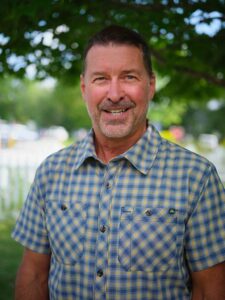
Paul Drinan on Active Transportation
Every month PelotonLabs founder Liz Trice interviews a community member for The West End News. This month Liz caught up with Paul Drinan, Active Transportation Director for the Bicycle Coalition of Maine.
What is active transportation and why should people who drive care about it?

Active transportation is defined as human-powered transportation. Think walking and rolling – it could be a bike, a wheelchair, a scooter or other mobility device. Active transportation is a great investment, both by governments and individuals. Every $1 invested in active transportation yields $3 in health savings, because we’re healthier when we walk and bike, and our mental health and social relationships improve, too. Active transportation is the most equitable form of transportation – nothing is more accessible, more affordable, cleaner, or safer. People who drive should support active transportation because every person who walks or rolls is one less person in a car, which means less traffic, less noise, less pollution.
I have friends who live on busy roads that feel unsafe, so they have to drive everywhere.
Everyone has the right to be able to walk and bike safely. The average trip in Maine is only five miles, which is totally doable on a bike – especially an e-bike. Most people don’t feel safe because nearly 100% of our roads are designed exclusively for cars. Since about the 1940s, almost 100% of our transportation systems have been dedicated to creating space for cars. Before that, transportation investments went into walking, trains, trolleys, and yes, bikes. Did you know that roads were originally paved for bicycles?
What are the top priorities in your new role at the Bicycle Coalition?
My role includes advocacy, policy, and legislation. My top goals are to greatly expand the statewide e-bike rebate program, install automatic speed cameras in school zones and work zones, and ensure one hour of bike/ped education per year for Maine students starting in middle school. Everyone goes to driver ed but nobody understands bicycle and pedestrian rights and responsibilities. It’s not an either-or, we need both.
It seems like it would be so easy and inexpensive to just paint lanes narrower and leave larger shoulders for bikes. Why isn’t this happening?
It feels like an oversight, but it’s not. It’s an inherent flaw in today’s transportation engineering standards. What we’re talking about – reclaiming space from cars for people – requires a cultural shift and it takes a lot of work to get it done. You have to organize the people in your neighborhood, work with DOT and your municipality to get changes to any road. BCM can help, but it really requires a public appetite and bold leadership at the local level.
Thankfully, Pete Buttigieg, the current Secretary of Transportation, understands, appreciates, and is funding active transportation and there are currently tens of millions of dollars available to make these changes in your community.
How can we change it fundamentally? What is Vision Zero?
Vision Zero’s goal is to reduce roadway injuries and fatalities to zero. Biking and pedestrian deaths are totally preventable. We have to redo our standards to build safer roads for all users. That means protected bike lanes, better crosswalks, bump-outs, daylighting, and refuge islands. When people feel safe, they adopt new modes of transportation. In the last few years, Vision Zero has been adopted by USDOT and Maine’s Regional Planning Organizations (MPOs). Now we need the local municipalities to adopt it, and community members will have to push to get it implemented.
What’s the most powerful thing we as residents can do to turn this ship?
You can insist on your right to feel safe in public right of ways. Talk to family and friends about strategies and solutions that work like Vision Zero and Safe Streets For All. You can join the Bicycle Coalition of Maine, take BCM’s Community Spokes training, and join your local bicycle and pedestrian advisory committee. You can write letters to city councilors and state reps, and I can help communities create those talking points. That’s my job.
What do you want everyone to know?
I want people to know that they have the right to be in the road and feel safe doing it, whether it’s crossing the street, riding a bike, on a skateboard, in a wheelchair, or in a car. They also have a responsibility to respect all other users and obey the law. Please contact us at bikemaine.org for more information.
This interview with Paul Drinan was edited for brevity and clarity.





